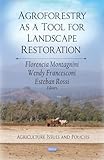Agroforestry as a tool for landscape restoration / Florencia Montagnini, Wendy Francesconi and Esteban Rossi, editors
Montangini, Florencia [editor] | Francesconi, Wendy [editor/a] | Rossi, Esteban [editor/a].
Tipo de material: Libro
impreso(a)
Series Editor: Nueva York: Nova Science Publishers, 2011Descripción: vi, 201 páginas : fotografías, ilustraciones, mapas ; 26 centímetros.ISBN: 161728940X; 9781617289408.Tema(s): Sistemas agroforestales
Libro
impreso(a)
Series Editor: Nueva York: Nova Science Publishers, 2011Descripción: vi, 201 páginas : fotografías, ilustraciones, mapas ; 26 centímetros.ISBN: 161728940X; 9781617289408.Tema(s): Sistemas agroforestales| Tipo de ítem | Biblioteca actual | Colección | Signatura | Estado | Fecha de vencimiento | Código de barras |
|---|---|---|---|---|---|---|
| Libros |
Biblioteca Campeche
Texto en la configuración de la biblioteca Campeche |
Acervo General | 634.99 A36 | Disponible | ECO040006202 |
Incluye bibliografía e índice: páginas 195-201
Preface.. Section 1- Agroforestry systems designed to restore degraded lands to productive land use systems yielding subsistence goods for rural people.. Chapter 1. Imitating natural ecosystems through successional agroforestry for the regeneration of degraded lands - a case study of smallholder agriculture in northeastern Brazil.. Chapter 2. Tavy bôka: a Malagasy alternative to slash and burn agriculture.. Chapter 3. Restoration of equatorial rainforest slopes of Mabonji in the Meme division, Southwest region of Cameroon.. Chapter 4. Constraints of tree establishment and their role in rehabilitating degraded dry land in Sudan.. Chapter 5. Restoration of degraded pastures using agrosilvopastoral systems with native trees in the Neotropics.. Chapter 6. The Multispecies Agroforestry System of the Danac Foundation in tropical dry forest landscapes of Yaracuy, Venezuela (a case study.. Section 2- Agroforestry systems designed to restore soil while focusing on non-timber forest products.. Chapter 7. Non-wood products from native multipurpose trees from agroforestry homegardens in the semiarid Mexican Plateau.. Chapter 8. Effects of native trees in agroforestry systems on the soils and yerba mate in Misiones, Argentina.. Section 3- Agroforestry systems to restore and conserve biodiversity in agricultural landscapes.. Chapter 9. Effects of management practices on coffee productivity and herbaceous species diversity in agroforestry systems in Costa Rica.. Chapter 10. Using bird distribution to evaluate the potential of living fences to restore landscape connectivity in pasturelands.. Chapter 11. Operationalizing environmental services of agroforestry systems: Functional biodiversity assessment in Tomé-Açú, Pará, Brazil.. Section 4- Agroforestry systems for watershed restoration and conservation.. Chapter 12. Riparian Buffers for Habitat Enhancement of Beaverlodge Watershed - Alberta, Western Canada
Chapter 13. Agroforest landscape ecosystem analysis in Mindanao, Philippines: current status and perspectives for watershed restoration.. Section 5- Agroforestry dissemination and training.. Chapter 14. Agroforestry educational experiences for smallholders involved in biodiversity conservation and landscape restoration in the Xingu Watershed - Mato Grosso, Brazil.. Index
The book is comprised of 5 sections with a total of 14 chapters. The articles selected provide an overview of recent efforts to apply agroforestry technologies to landscape restoration in degraded lands located in tropical and temperate regions worldwide. The book is directed at a broad audience including academics, practitioners, and policy makers. The topics, problems and objectives in each chapter vary according to the specific circumstances of ecosystem or landscape degradation, ranging from extreme conditions and solutions such as sand embankments and vegetative barriers in arid regions of Sudan, to degraded agricultural or pasture lands, implementing successional analog ecosystems in the Brazilian Amazon, "agrotropic-rainforestry" systems in Cameroon, traditional shifting agricultural technologies without burning in Madagascar, agrosilvopastoral systems in Costa Rica, or reforestation with taungya systems in Venezuela. Several chapters focus on soil restoration and sustainable production of subsistence goods, as well as non timber forest products in Cameroon, Mexico and Argentina. Several chapters are dedicated to describing agroforestry systems aimed at the provision of environmental services such as biodiversity conservation and protection of watersheds. The book closes with a chapter stressing the importance of working with local people, and providing education and extension services to local communities. This collection of articles intends to call the attention of practitioners, academics and policy makers to key issues and approaches in agroforestry that can be useful to address the complex environmental and productivity problems of degraded agricultural lands throughout the world. eng
